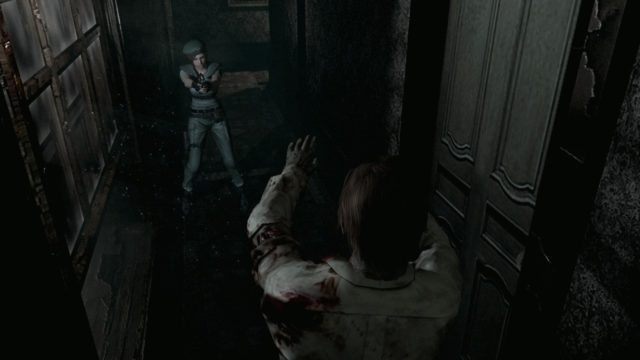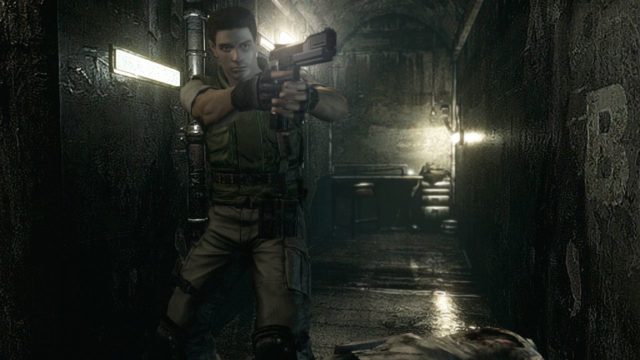Superb sense of tension; great visuals
Static camera; dated control scheme; irksome item management
It was 2002. After a fairly strong launch, GameCube truly came into its own in its sophomore year, thanks to classic games such as Metroid Prime, Animal Crossing and Super Mario Sunshine. Things truly kicked into gear, however, with the release of Resident Evil. A remake of the 1996 original, the GameCube iteration brought with it a graphic overhaul, improved dialogue and various additional tweaks, making it the definitive version of Capcom’s classic. Now the remake has been ported to Switch with HD visuals and portable gameplay. Fortunately, the game is every bit as endearing as it was back then.
In Resident Evil, the STARS team has been dispatched to investigate a strange series of cannibalistic murders in the woods outside of Raccoon City. Players choose between team members Chris Redfield or Jill Valentine as they are forced to investigate Spencer mansion, the epicenter of the attacks. The mansion is, of course, infested with the Umbrella Corporation’s T-Virus experiments, including zombies, dogs, crows, sharks and a number of other disturbing creatures. In order to survive, players will have to know when to run and when to fight, as ammo can be fairly limited throughout the mansion. Sometimes, keeping an enemy alive is a better strategic decision, particularly in areas with room to navigate.
While battling these entities is a big part of the game, the majority of the focus is on puzzle-solving and exploration, and that element is sure to be the most divisive one for franchise newcomers. Spencer Mansion is littered with different key types and knickknacks, which must be discovered and thoroughly investigated in order to progress. While some puzzles can be rather intuitive, others can be far less so, tasking players with truly wracking their brains to figure out each solution. Complicating matters is the game’s item management. Chris and Jill can only hold a set number of items (six and eight, respectively), which means players have to opt not to pick up key items at times, or leave them in the game’s universal item boxes. Either way, players will have to do a lot of backtracking, as a result. This process results in a lot of guess and check, and some players will undoubtedly find themselves frustrated, at times.

If there’s one thing that has aged incredibly well in Resident Evil, it’s the game’s superior sense of tension. Between the haunting visuals and fantastic use of sound and music, the tension superbly builds as the game progresses. Every sound is capable of making you feel something, whether it’s a sense of dread when a zombie moans off-camera, or the relief associated with the Save Room music. Few other games have managed to achieve that same level of tension, including subsequent titles in the Resident Evil franchise. It’s all still here and it all still works just as well as it did before.
What hasn’t aged nearly as gracefully is the game’s use of static camera angles and “tank-like” controls. While those static camera angles produce some undeniably gorgeous visuals, the constant perspective changes add another level of frustration. There’s nothing more irritating than having the angle switch in the middle of a room and suddenly you’re tilting the control stick in the wrong direction. Or hearing a zombie shambling off camera and not being able to see it simply because of the fixed angle. It’s by no means a deal-breaker, but it will remind players why Capcom decided to change things up in more recent titles.

One of the game’s more unforgiving elements in its other incarnations was the save system. Jill and Chris use ink ribbons and typewriters to save their progress. Ink ribbons are found in bundles of three, and can only be used to save the game when a typewriter is located. While the save system hasn’t changed any, it’s far more forgiving when coupled with Switch’s sleep mode. Should one of the game’s T-Virus creations kill Chris or Jill, players will still find themselves sent back to the last official save point, but it’s nice not to have to burn through an ink ribbon every time I wanted to quit for the day. On the flip side, I often found myself forgetting when I saved last when starting up from sleep mode, but it’s well worth the trade-off.
Outside of the HD visuals and portable gameplay, Resident Evil does feature a handful of small improvements over the GameCube original. Achievements have been added, and there are also online leaderboards, where players can see how they rank against some of the fastest players in the world. While both additions are fairly minor, they do add to the game’s overall replay value.
Resident Evil’s flaws are every bit as glaring today as they were back in 2002. The controls, the awkward camera and the game’s item management are all sources of irritation. And yet, despite these issues, Resident Evil HD is still an undeniable classic. No other survival horror game has managed to channel the same compelling level of tension. If you’ve ever played Resident Evil in any of its incarnations in the 23 years since its original release, you’ll know exactly what to expect: one of the most genuinely unnerving games the industry has ever produced. Having the game in portable form is just extra icing on the cake.
Nintendojo was provided a copy of this game for review by a third party, though that does not affect our recommendation. For every review, Nintendojo uses a standard criteria.




 ShareThis
ShareThis





